Located in the Red River Delta of northern Vietnam, Ninh Binh Province is home to several famous attractions of nature and culture, and the most notable one is Trang An Scenic Landscape Complex. This province is where tourists gather to enjoy the beautiful nature and the indigenous culture of the northern Vietnamese. Ninh Binh shelters the mysterious caves, intact forests, historical landmarks, and national parks, which make tours to Ninh Binh nowadays a top pick for all holidaymakers. If your interests are in natural attractions and historical places, then Ninh Binh is the right destination. The actual visit will bring you to the world of pristine landscape in which the skyscraper or commercial buildings lose their impact. Rather, the ancient temples, the forests, the grottoes, and the rivers dominate the land. This introduction to Ninh Binh provides all information you need to know about this charming destination, which can inspire you to pack and go there one day. What food to eat in this place of interest? Where to go for a day full of explorations? Read on to answer some of the questions you might have regarding this enchanting corner of Vietnam.
Overview of Ninh Binh
Around 91km from the center of Hanoi City, Ninh Binh Province is accessible by train, bus, private car, and even motorbike. Travelers find it super-easy to visit the destination nowadays. Ninh Binh is home to the UNESCO-inscribed Trang An Scenic Landscape Complex which keeps attracting holidaymakers nowadays. The destination has the gifts of forests, caves, and wetland nature reserves for perfect ecotourism. Also, the ancient remnants of the capital, king’s tombs, temples, and cathedrals make Ninh Binh “a living museum” to learn about the history and religion of Vietnam. The most popular tours include a must-have boat trip to explore the beauty of Trang An and access the water caves across the intact areas. People keep sharing their pictures and videos about the boat trip in Trang An which inspires other guests to join and experience. Ninh Binh plays an important role as a gateway for cultural and economic exchanges between the Red River Delta and the northern provinces of Vietnam. Its economic strength mainly comes from the tourism and construction material industries.
Geographical Location
Ninh Binh Province is located between the Red River and Ma River and is the southernmost coastal province of the Red River Delta in northern Vietnam. The province is bordered by Ha Nam to the north, Thanh Hoa to the south, Nam Dinh to the east, and Hoa Binh to the west. It has a coastal area of 16km; Ninh Binh is the province with the shortest coast in Vietnam. It has a total area of 1,329.4 square kilometers. Also, Ninh Binh is around 91km from Hanoi, which is accessible by train or road transport links. Thanks to the coastline neighboring the Gulf of Tonkin, the province has several attractions of water caves that attract tourists. Besides, it is home to the vast Cuc Phuong National Park featured primitive forests and ancient caves. With swamps, forests, caves, etc., Ninh Binh was filmed in the Hollywood movie of Kong: Skull Island. The scenery of the destination in the movie was absolutely amazing. The ecological sights and the historical sights make Ninh Binh a praiseworthy destination for both eco-tourists and history buffs to travel all year round.
Weather Characteristics
In Ninh Binh, January is the coldest month with an average temperature of 15.7 Celsius degrees. Besides, the hottest month in this province is June when the average temperature might even reach 30 Celsius degrees, but it is also when Ninh Binh has more daylight hours than any other month. Generally speaking, Ninh Binh features a humid subtropical climate. So, it’s hot and humid in the summer while the rainy season begins from June to October. The average temperature is 23.5 Celsius degrees. If you ask for the most beautiful time to travel to Ninh Binh, then let’s go in the spring and the summer. While January – March features the springtime with a favorable climate, April – June is when Ninh Binh enters the harvest season with the yellow rice fields and comfortable warm climate.
In the spring (January – March), Ninh Binh pleases guests with less rain, a chill climate, and favorable conditions for sightseeing and exploration. This period is also ideal for pilgrimage activities like visiting Bai Dinh Pagoda, Trang An Scenic Landscape Complex, and Phat Diem Stone Cathedral. In the summer (April – June), the Ninh Binh climate is quite cool and pleasant, neither cold nor scorching. This is the best time to admire the golden rice beauty of the vast fields in Tam Coc and the diverse ecological system in Cuc Phuong National Park. The pleasant sunny condition is a precious opportunity for artistic photographs. If you have a plan to travel during the winter, it’s advised to check the weather forecast before the trip as winter in Ninh Binh is very cold and harmful which might drive you to catch a cold. Bring your warm clothes if you go at this time.
Ninh Binh History and Development
Ninh Binh in the ancient time: B.C
Under the Tan dynasty (255-207 B.C), Ninh Binh was of Tuong District. During the second Chinese domination period (207 B.C – 542 B.C), under the reign of the Han dynasty, Ninh Binh was in the Giao Chi district. Also, under the reigns of the Ngo dynasty (266-280) and Tan dynasty (280-420), it was in the Giao Chau district. Then, till the end of the Luong dynasty (502-542), it was named Truong Yen. When Ly Nam De defeated the Luong enemy and established the Tien Ly dynasty (542-602), Ninh Binh was still of Truong Yen of Van Xuan country. Then, during the third Chinese domination period (603-905), this area was under the Tuy and then Duong dynasties, and still of “Chau” Truong Yen.
Ninh Binh History during the feudal periods: Dinh, Le, Ly, Tran, Ho, and Tay Son
When Dinh Bo Linh finished conquering the 12 warlords and reunited the country to establish the Dinh dynasty (968-980), he proclaimed himself an emperor and decided to locate in Hoa Lu, which was named “Chau” Dai Hoang of Dai Co Viet country. When it came to the Tien Le dynasty (981-1009), the area was named “Chau” Truong Yen. Under the Ly dynasty (1010-1225), it was named “Phu” Truong Yen, later called “Chau” Dai Hoang of the Dai Co Viet country.
In the Tran dynasty, it was called “Tran” Truong Yen. In the 10th year of Quang Thai (1398), king Tran Thuan Tong renamed it “Tran” Thien Quan. During the periods under Minh domination (1407-1428), it was called back “Chau” Truong Yen and was later incorporated into “Phu” Kien Binh including other districts.
Under the Le dynasty, the area remained unchanged as the previous Tran dynasty. When it came to the Thieu Binh era (1434-1440) under the reign of Le Thai Tong (1433-1442), the area was subdivided into 2 units of “Phu” Truong Yen and “Phu” Thien Quan, which belonged to the Thanh Hoa district.
Under the Mac dynasty (1527-1592), the two units were called Thanh Hoa Ngoai Tran. The areas from the “Phu” Truong Yen unit to the north were managed by the Mac family while the rest were controlled by Le Trung Hung. The names Thanh Hoa Ngoai Tran (external zone) and Thanh Hoa Noi Tran (internal zone) were used from this period. When the Mac dynasty was ended (1592), the Le dynasty combined “Phu” Truong Yen and Thien Quan into Thanh Hoa Ngoai Tran. Then, in the Tay Son period, it was still called Thanh Hoa Ngoai Tran of the northern zone.
Ninh Binh History under the Nguyen dynasty
Ninh Binh was remained unchanged under the Nguyen dynasty: Thanh Hoa Ngoai Tran consisted of “Phu” Truong Yen and Thien Quan, with 6 townships of Yen Mo, Yen Khang, Gia Vien, Yen Hoa, Phung Hoa, and Lac Tho. In the 5th Gia Long Year (1806), the Thanh Hoa Ngoai Tran was changed to “Dao” Thanh Binh. In the 2nd Minh Menh Year (1821), Phu Truong Yen was renamed as “Phu” Yen Khanh.
In the 3rd Minh Menh Year (1822) “Dao” Thanh Binh was changed to “Dao” Ninh Binh. The name Ninh Binh was established during this time, but it was still a unit of the Thanh Hoa district. In the 10th Minh Menh Year (1829), it was officially changed to the Ninh Binh district. In the 12th Minh Menh Year (1831), Ninh Binh district was made to the Ninh Binh Province. The Ninh Binh Province under the reign of the Nguyen dynasty included two units (Yen Khanh and Thien Quan) and 7 districts.
Ninh Binh History during the Revolutionary Period
In 1930, the Communist Party of Vietnam was founded, when Ninh Binh was one of the provinces with the communist party base and revolutionary movements. During the fights against the American army, Ninh Binh maintained the north-south traffic links. The people of Ninh Binh shot down 90 American planes.
Before the August Revolution (1945), Ninh Binh had 6 independent districts. After the August Revolution, some districts were named after famous characters or historical destinations; Ninh Binh was named Hoa Lu Province for a short period. On 9 October 1945, the governing council decided that the provinces were renamed to their original names, so Hoa Lu was changed back to Ninh Binh district. During wartime against the French army (1946-1954), Ninh Binh Province was of Region 3, then of Interregional 3. After the reunification day in 1976, Ninh Binh was combined with Ha Nam Province to establish Ha Nam Ninh province. In 1977, the original land of Ninh Binh only included 4 districts left included in Ha Nam Ninh province, of which Ninh Binh township was of Hoa Lu district.
Ninh Binh History in the Renovation Period
In December 1991, The 8th National Assembly of the 10th session decided to separate Ninh Binh province from Ha Nam Ninh province. Ninh Binh was made back to the Province with 7 administrative units, namely Ninh Binh town, Tam Diep town, and 5 districts of Hoang Long, Hoa Lu, Gia Vien, Tam Diep, and Kim Son. In November 1993, the Hoang Long district was changed to the Nho Quan district. In July 1994, Tam Diep district was renamed back to its old name of Yen Mo and re-established the Yen Khanh district.
Nowadays, Ninh Binh Province has an area of 1387,5 square kilometers, with 8 administrative units, including 2 cities (Ninh Binh and Tam Diep) and 6 districts (Nho Quan, Gia Vien, Hoa Lu, Yen Mo, Yen Khanh, and Kim Son). Over thousands of years of establishment and development, Ninh Binh has gone through 10 names other than Hoa Lu and Ninh Binh:
- “Chau” Truong Yen
- “Chau” Dai Hoang
- “Chan” Thien Quang
- “Phu” Kien Binh
- “Phu” Truong Yen
- Thanh Hoa Ngoai Chan
- “Dao” Thanh Binh
- “Dao” Ninh Binh
- “Tran” Ninh Binh
- Ha Nam Ninh
Introduction to Ninh Binh Means of Transport
There are ways to get to Ninh Binh from Hanoi as the two destinations are supported by convenient roadway links and trains. As Ninh Binh is around 91km from Hanoi, it often takes around 1.5 – 2 hours by car transfer, which is subject to the traffic. Other channels include buses, private cars, or even motorbikes. In general, there are 4 popular ways to move between Hanoi and Ninh Binh.
- First, you can hire a private car with a driver if you’re going in a small group and want privacy. It often costs USD 70 for a 4-seat car, which will pick you up anywhere in Hanoi city and then carry you to many attractions in Ninh Binh. This means of private channel helps remove any worry about missing a bus or moving in the bad weather or traveling with a large suitcase.
- Second, traveling by bus is an affordable way, which takes about 2.5 hours for transferring on this route. Passengers can opt for either the regular bus (USD 5 for a one-way ticket) or the limousine bus (USD 9 for a one-way travel). For the regular bus, you need to come to the bus stations to catch a bus. It offers no pick-up and drop-off services, so you have to find the ways by yourself. For the limousine bus (which is a little more expensive), it offers the pick-up and drop-off services to the tourist attractions in Ninh Binh. For the limousine, you need to work with a reliable travel agent or ask the hotel receptionist to book the ticket for you. This way, the limousine bus will be waiting for you at the hotel, and then take you to the needed addresses.
- Third, the train is another good channel to move between Hanoi and Ninh Binh on the North-South railway line. The train ticket will cost around USD 5 per one-way ticket. By train, the journey will take 2 hours, of which you can choose the sleeper berths, hair chairs or soft chairs. Note that Ninh Binh train station is quite close to the famous Trang An Complex, so it’s a smart plan to first visit Trang An upon your arrival.
- Fourth, if you dare to ride, let’s travel by motorbike to move from Hanoi to Ninh Binh. But, make sure you check the route before the ride and follow the local rules such as wearing a helmet and checking your travel insurance.
To get around Ninh Binh, you can use the official taxi service like Ninh Binh Taxi, Mai Linh Taxi, Minh Long Taxi, Hoa Lu Taxi, and Xuan Thanh Taxi. For your benefit, remember to write the exact address on a piece of paper or your phone and show it to the driver. You can also write down the prices to avoid misunderstanding. Or you can experience the local motorbike taxi (Xe Om) to move around the adjacent attractions. Or in the town center, you can easily catch a bus to move around and observe the local scenery and lifestyle.
Introduction to Ninh Binh Best Tourist Attractions
Trang An Scenic Landscape Complex
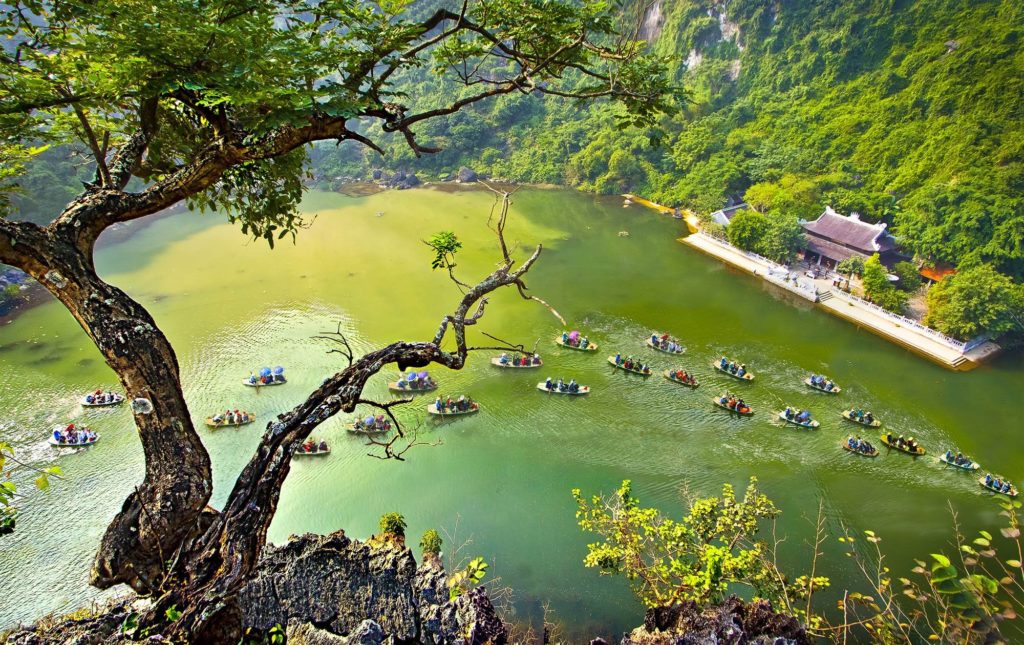
Trang An is number one in the list of the most famous tourist sites in Ninh Binh. With the pristine and imposing nature, plus the cultural values, Trang An was inscribed as a UNESCO Cultural and Natural Heritage Site in 2014. The Complex is located near the southern margin of the Red River delta. It represents a mixed cultural and natural property including three protected zones: 1) Hoa Lu Ancient Capital, 2) Trang An – Tam Coc – Bich Dong Scenic Landscape, 3) Hoa Lu Special-use Forest. Much of the property remains rural with rice fields, uninhabited, and in an intact state. The landscape from the top dimension looks just perfect, with the rivers winding through the limestone formations, resulting in the mysterious grottoes. The best channel to explore this UNESCO site is a small boat trip which can navigate through the waterways to access the karst towers and narrow cave passages. The whole landscape is beautiful and tranquil. The blend of the towering mountains draped in rainforests is awesome for sightseeing and photography. Everybody will be pleased at watching the exceptionally beautiful tower karst landscape from every angle.
Trang An is around 7km from Ninh Binh station and 8km from Ninh Binh train station. The entrance ticket to Trang An is VND 250,000 / adult, 6 adults per boat; VND 120,000 / child. If you want a tour guide accompanied, pay VND 300,000 / tour.
Tam Coc – Bich Dong
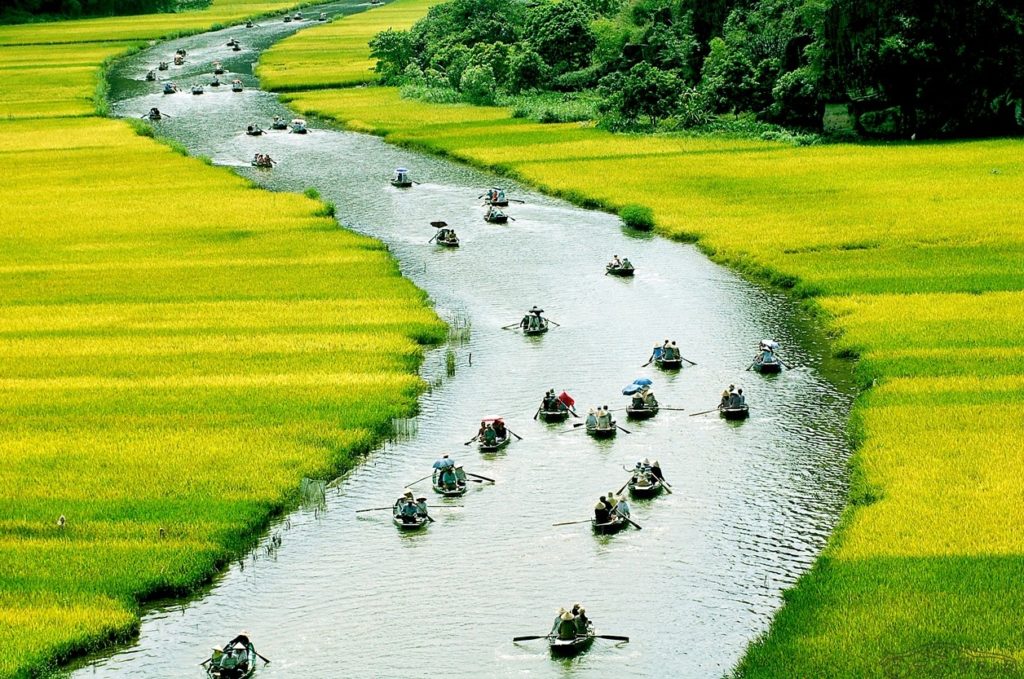
Included in the scenic landscape of the UNESCO-inscribed heritage site, Tam Coc is recognizable for the sublime greenery, majestic limestone cliffs, and attractive waterways. It remains intact for perfect nature photography. The name Tam Coc refers to the “three caves”: Hang Ca – Hang Hai – Hang Ba, penetrating through mountains and over the calm water of the Ngo Dong River. The limestone caves and rock formations establish the mysterious sceneries for sightseeing and photography during a boat trip. It costs VND 150,000 per boat accommodating 4 passengers. Furthermore, you can visit the caves of Bich Dong including a dried cave located halfway down the mountain and a water cave. On the mountain, there preserves a little old pagoda that attracts pilgrims across the country. The ancient gate and the antique wooden architecture of Bich Dong Pagoda will tell its history. Historically, this pagoda was erected in 1428 under the reign of Le Thai Ton. The peak season of this site is May – June, when the rice fields turn yellow, which is very beautiful. Make it a must to experience a boat trip to sail along the Ngo Dong River and appreciate the beauty of nature as well as history.
Hoa Lu Ancient Capital

Hoa Lu was the capital of Dai Co Viet during the period 968 – 1009 under the reigns of Dinh, Tien Le, and Tien Ly. In 1010, Ly Cong Uan King, the founder of the Ly dynasty, moved the capital to Thang Long (now Hanoi), which made Hoa Lu “the ancient capital.” In an area of 300 hectares, Hoa Lu included the inner and outer citadels that featured defensive walls, palaces, shrines, and temples. The whole area was surrounded by limestone mountains, which provided it the secure protection. Nowadays, a few vestiges of the 10th century remain. The site is around 90km from Hanoi city. The ancient capital is included in the complex inscribed as the UNESCO Cultural and Natural Heritage Site, together with Trang An – Tam Coc – Bich Dong Scenic Landscape and Hoa Lu Special-use Forest. Monuments to see in the area include the temple of Dinh Tien Hoang, the temple of Le Dai Hanh, Nhat Tru Temple, the temple of Dinh Tien Hoang’s daughter, and Thien Ton Cave. Especially, Hoa Lu hosts an annual festival in the 3rd month of every lunar year, when a procession starts from the Hoang Long River to the temples of the two kings. The event is to commemorate the Vietnamese history between 968 when Dinh Bo Linh proclaimed himself an emperor and 1010 when Ly Cong Uan transferred the capital from Hoa Lu to Thang Long. Over 1000 years of historical ups and downs, Hoa Lu is an important historical heritage for the later generations to study and witness. The entrance ticket is VND 20,000 / person.
Mua Cave

Mua Cave is situated at the foot of the Mua Mountain, Ninh Xuan Commune. This place of interest is noticeable for the green and mystic landscape amid the lush rice fields. The view of the scenery from the top dimension looks amazing. To reach the top of the cave site, visitors will need to climb up 500 steps of the old staircase, from which the entire view is enthralling. It’s also possible to view the local fishing boats in a distance. This is a wonderful place to marvel at the sunrise and sunset. Also, inside the cave is a small temple dedicated to worshipping Goddess Quan Am. What makes Mua Cave distinctive could be the beautiful, pristine, and quiet atmosphere that lets every soul feel calm and peaceful. From the foot of the mountain, it’s clear to see the stairs leading up to the top, which looks similar to a miniature of the well-known “Great Wall” of China. Pictures taken in Mua Cave look historic and artistic. You’d better wear comfortable clothes to climb the mountain and take sporty shots. Mua Cave is around 5km from Tam Coc – Bich Dong, and the entrance ticket is VND 100,000 / person.
Am Tien Cave
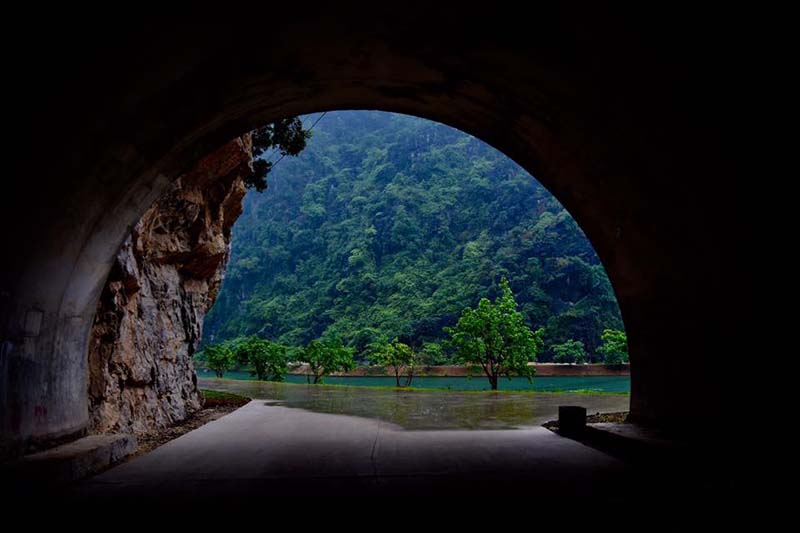
As a monument included in Hoa Lu National Relic Complex, Am Tien Cave is a haven to explore as long as you want a poetic and peaceful landscape to unwind and photograph. This retreat site owns the unspoiled beauty, which seems to separate from the busy outside world. The young tourist communities call it a “No Love Site,” where people know no love, so no sorrow at lovesickness. The whole scenery looks slightly touched by the laidback tone. So, people feel that they can hide or run away from melancholy in this address. The entrance ticket to Am Tien Cave is VND 20,000 / person. Nature photography of this “No Love” cave has the perfect blend of colors and objects. You must take a series of “so-deep” photographs when getting there.
Thung Nham Bird Sanctuary
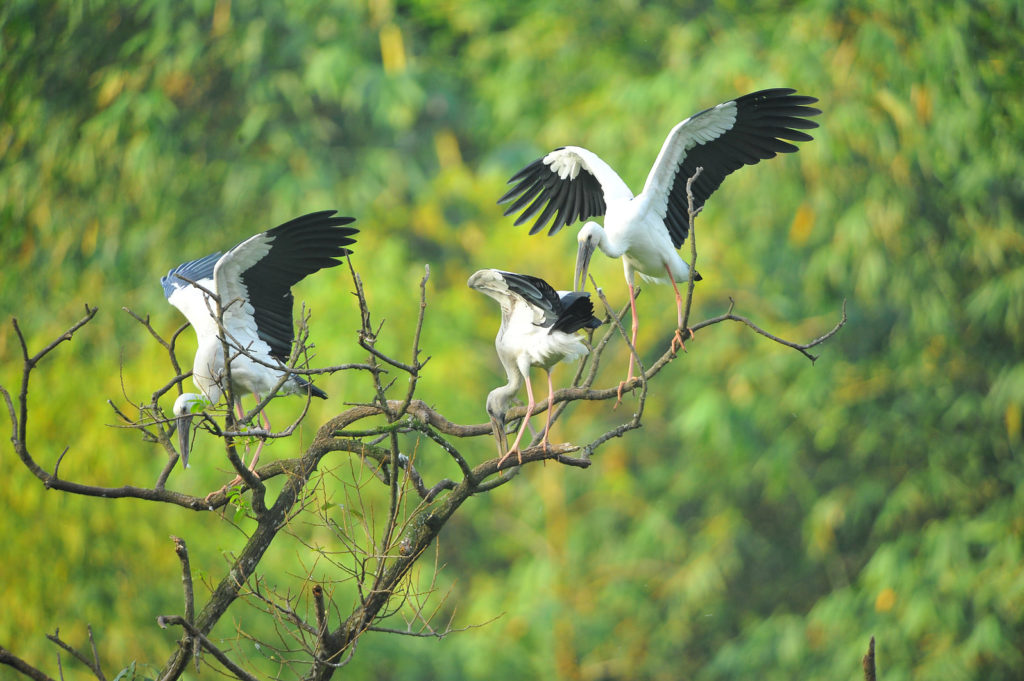
This is a sanctuary for birds and also for nature lovers who enjoy being close to the primitive forests and the communities of birds. The whole landscape is just perfect, with the lush forest, mysterious caves, and gorgeous valleys, which are nicely combined, amid the leaves and flowers. Thung Nam is where you can meet up to 400 species of birds, watch their lives, and explore their habits. There protect up to 50,000 birds. During the twilight, you can expose to the sky filled with flying birds, which results in wonderful intact scenery and is hard to find elsewhere.
Van Long Wetland Nature Reserve
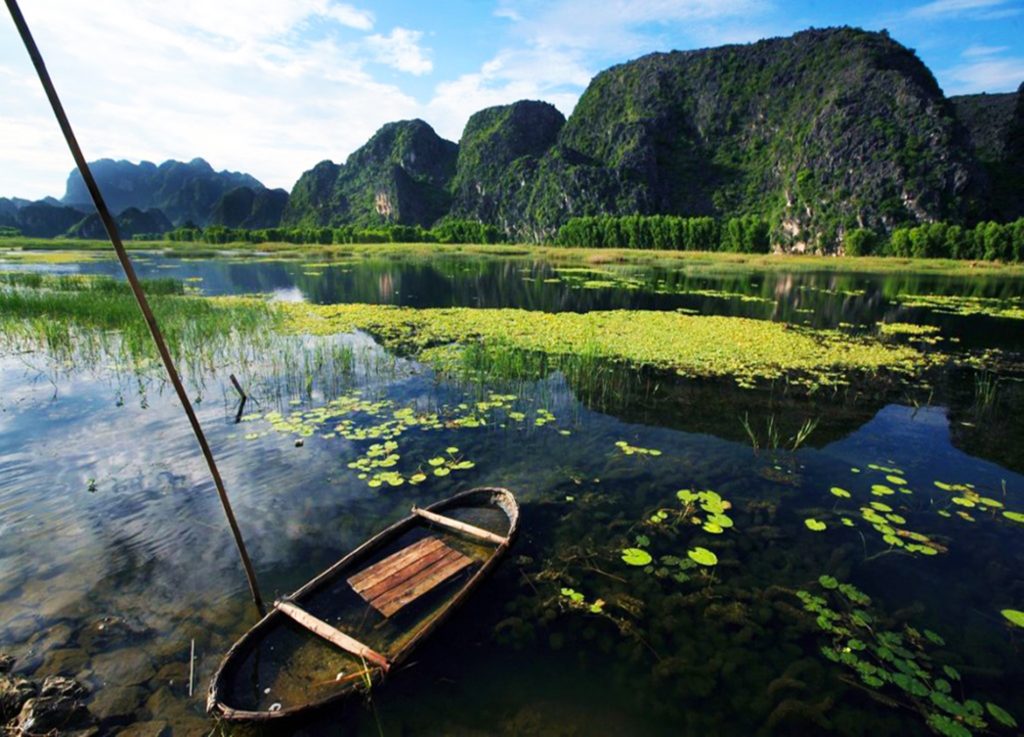
As an eco-tourist site, Van Long Wetland Nature Reserves offers poetic and enchanting scenery, which is best explored by a boat trip. The site has an area of 3,000 hectares, which makes it the largest wetland nature reserve in the Red River Delta. During a boat trip, guests will enjoy sightseeing on the calm water surface, which looks like a giant mirror. This place is also called “a bay without waves” by the locals. As the boat keeps rowing, you will find yourself being amid the enthralling sceneries and the vast swamp that is also home to birds, langurs, and limestone mountains. The mountains appear in the interesting shapes of a fairy, a raspberry, a trunk, etc. This place can make you a poet if you like. The entrance is VND 20,000 / sightseeing ticket and VND 80,000 / boat.
Cuc Phuong National Park
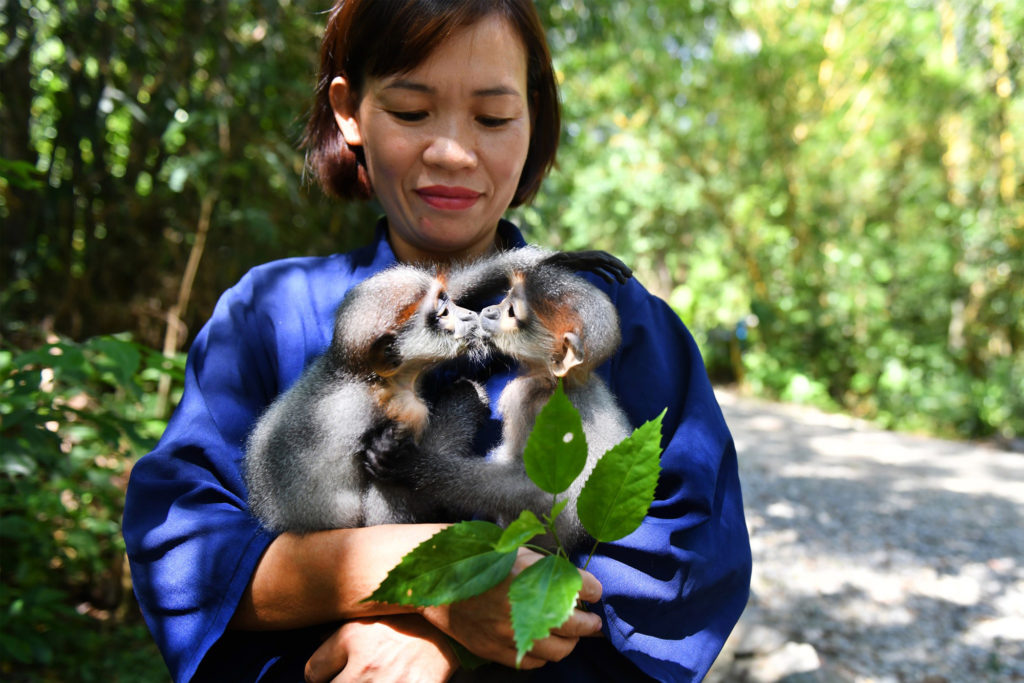
Cuc Phuong National Park has a total area of 25,000 hectares and is a famous ecotourism destination, which attracts hundreds of visitors every year. This is a haven for eco-tourists and nature fanciers who love sightseeing the gorgeous landscape, exploring the rich flora and fauna, participating in ecotourism activities, and learning about the culture or history of the land. The destination is perfect for a day tour, but if you want to experience more, opt for a trip of 2-3 days. The best months to visit Cuc Phuong are June and July when many corners of the park become beautified with colorful butterflies. On a national scope, Cuc Phuong is Vietnam’s first national park and largest nature reserve. It is also one of the most important places for biodiversity in Vietnam. The park is located in the foothills of the northern Annamite Range, featuring the verdant karst mountains and lush valleys, of which each limestone mountain has numerous accessible caves for exploration. Opening for tourism, Cuc Phuong National Park preserves the off-the-beaten-track paths for hiking, which attracts hikers across the country.
Bai Dinh Pagoda
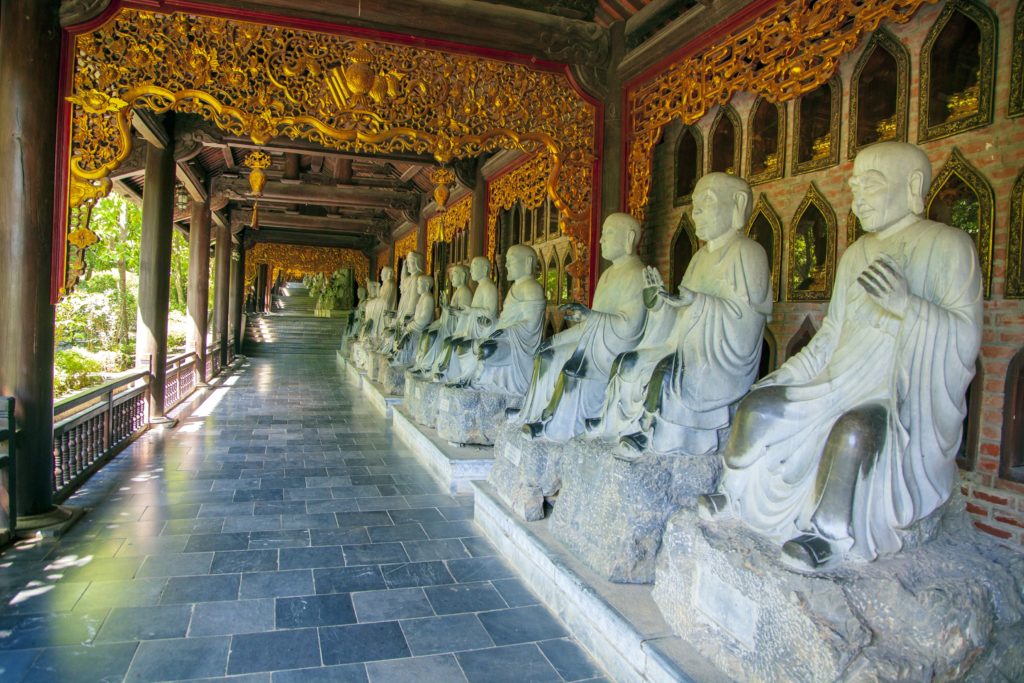
Bai Dinh is one of the largest ancient pagodas in Vietnam. It remains a revered center of Buddhism for pilgrimage and learning. Located around 15km from Ninh Binh City, the grand Bai Dinh Pagoda has established several national records namely the pagoda with the Largest “Dai Hong Chung” in Vietnam, with the Tallest and Heaviest bronze Buddha Statue in Vietnam, with the Largest well in Vietnam, and with the largest number of Arhat stone statues in Vietnam. With several “best” records, Bai Dinh Pagoda is a pride of Ninh Binh attractions and is a must-see for Buddhist pilgrims who come to pray for health, wealth, and every good thing in the world. This pilgrimage destination owns fairylike scenery which helps visitors feel peace and purity from the heart. This is where you should always visit at least once upon arrival at Ninh Binh. The values of the visit are precious for both mind and body. This pagoda has a critical role in the locals’ spiritual beliefs and also in the whole country’s religious merits. Getting there, make sure you visit “Gieng Ngoc” (Pearl Well) – the largest well inside a pagoda in Vietnam, the largest bronze bell in Vietnam, and the longest Arhat corridor in Vietnam, plus many attractive scenes.
Phat Diem Cathedral

Phat Diem Cathedral or Phat Diem Stone Church is a complex of Catholic churches, in an area of 22 hectares, located in Phat Diem Town, Kim Son District, Ninh Binh Province. This church is considered one of the most beautiful churches in Vietnam and can function as the “Catholic capital” of Vietnam. Constructed in 1891 from stone and wood, Phat Diem was put into operation in 1898. The site was bombed in 1972 and then restored. Though being a Catholic Church, Phat Diem was modeled on the traditional capital architecture of Vietnam, which gave it unique characteristics that could be found in no other churches. It was once described as “more Buddhist than Christian.” Take note of the vaulted ceiling with paintings of angels in the Vietnamese style. Moreover, the interior walls were adorned with Catholic iconography. Other interesting decorations were the Eastern religious symbols of dragons, phoenixes, tortoises, and unicorns. The architectural complex includes a large church with 4 other adjacent churches on both sides, 3 artificial caves with ponds, monuments, and communal houses. Around 121 km from Hanoi, the historical stone church with eclectic architecture is a must-see for everybody who gets to Ninh Binh.
Introduction to Ninh Binh’s Ideal Resorts and Hotels
Emeralda Resort Ninh Binh
Emeralda Resort Ninh Binh is located at Van Long Reserve, Gia Van Commune, Gia Vien District, Ninh Binh Province. This is a perfect Zen retreat for vacationers who want a quiet place to rest and meditate. The serene and beautiful resort is dedicated to your comfort, peace, and luxury, which enables you to stay away from the city noise or work deadlines. The accommodation is the right place to rejuvenate and revive. In a spacious villa style, the resort is well-equipped with a garden, spa, restaurant, swimming pool, etc., for top-notch comfort. Each suite and room is beautifully adorned for the Zen practices. This 5-star spa and wellness center is the top site to lay the heads in Ninh Binh if your budget can afford it.
Ninh Binh Hidden Charm Hotel and Resort
Situated in Tam Coc – Bich Dong Tourist Center, Ninh Binh Hidden Charm Hotel and Resort stands out as an attractive accommodation address for everybody to enjoy the comfort, great dining options, and convenient access to the adjacent attractions. The highlights of the resort also lie in the excellent massage, sauna, spa, fitness center, indoor swimming room, and yoga room. The place supports your beauty, mind and body, workout, and leisure so that even the stay in the resort is pleasant enough to please your time in Ninh Binh. There have been numerous great comments on the hotel facilities, cleanness, services, and nearby popular attractions.
Bai Dinh Garden Resort & Spa
Nestled in Hamlet 5, Bai Dinh Pagoda Area of Gia Vien District, Bai Dinh Garden Resort & Spa is another excellent accommodation to select. This address has received above 9 excellent reviews on Agoda regarding the room comfort, room quality, and services. Most comments are about the tranquil location, wonderful customer service, and great food, which ensure this resort a worthy place to invest your money. While the rooms are tastefully decorated and spacious, the gardens look fantastic, and the restaurants only serve delicious food. The place is highly recommended for couples, families, and even solo travelers who find no complaints during days and nights. It’s 750m from Bai Dinh Pagoda and offers very close distances from other popular attractions.
Mua Cave Ecolodge
If your selection criteria are about beautiful scenery and tranquility, then Mua Cave Ecolodge is the right place to settle down. Guests keep sharing that they would return to this eco-lodge for the next Ninh Binh trips, thanks to the gorgeous scenery from the hotel, the friendly staff, and the delicious Vietnamese food. If we can use two adjectives to describe this accommodation, then “beautiful and peaceful” are the right ones. Just next to the ecolodge is the charming “Hang Mua” for outdoor exploration and a great view of the rice fields plus the limestone mountains. The lovely setting of this address sets it apart from other sites.
Tam Coc La Montagne Resort and Spa
People all over the world keep sharing that they have had a great time in the luxurious Tam Coc La Montagne Resort and Spa. This property features the elegantly-designed rooms, helpful staff, and excellent customer service. As the property is located outside of the town, it provides the quiet, tranquil settings for guests to refresh, relax, and unwind. The sufficient facilities and amenities are to support your ultimate comfort. The view from the hotel balcony is stunning and you’re likely to see some local boats paddled by the Ninh Binh women and men. The lake view is peaceful and lovely, with a fresh breeze. Opt for a boat tour to Tam Coc and Trang An for a memorable vacation.
Aravinda Resort Ninh Binh
The property is located in the areas of Tam Coc – Bich Dong tourist center, where you can enjoy cycling around Ninh Binh. It’s a beautiful resort with a nice pool and lovely garden for awesome relaxation. The eco-design of the resort lets guests feel fresh and happy during the days and nights of staying indoors or moving outdoor around. The food in the restaurant is yummy though a bit pricy, but it’s worth the money. It offers a peaceful stay if you choose a noise-free vacation.
Introduction to Ninh Binh Food
Mountain Goat Ninh Binh
The mountain goat in Ninh Binh is more delicious than elsewhere. It is famous and unique. The reason is that the local goat is raised on the limestone mountains and eats a variety of leaves for the solid meat. Dishes from the mountainous goat can be served with several kinds of local vegetables and spiced by the locals’ secretive recipes, which make it a table delicacy of Ninh Binh. The flavors of rivers and mountains combined in the food make the goat meat a local specialty that everybody should try and evaluate. Also, the goat meat can be steamed, grilled, or made into sausage. It’s said that Ninh Binh goat meat is good for health and can cure some diseases.
Sticky Rice with Ant Eggs
Some people might misunderstand that the food made from ant eggs could only be found in the northern mountainous regions. Rather, Ninh Binh has a specialty named “Xoi Trung Kien” or sticky rice served with ant eggs. The Ninh Binh ant egg is originated from the limestone karst of Nho Quan Mountain. The locals will take the fresh ant eggs back home, wash them carefully, and then marinate them with spices. Finally, the ant eggs will be stir-fried. Then, the stir-fried eggs will be served with sticky rice and added with dried onions for a very strange and attractive taste.
Snake Eel Salad
Snake eel salad or Goi Ca Nhech is a delectable dish of the indigenous people in Kim Son – Ninh Binh. This kind of fish salad is processed in a delicate and complicated way, going through many steps to remove the fishy smell. The special trait of this food might also lie in the special sauce made specifically for the salad, which is a combination of chili, garlic, and pepper. The sophistication of the food makes foodies remember it for a long time. You can enjoy “Goi Ca Nhech” with rice crackers.
Ninh Binh Pancakes
You can find pancakes in many places across Vietnam, but Ninh Binh pancakes are different. The crispy cakes will be eaten with sticks of hot sausages. First, you will make the rice paper wet, then add cabbage leaves, pieces of pancakes, and sausage, and then roll the components together. Next, dip the whole roll into the succulent dipping sauce to enhance the taste. In addition, eat the sour elements on the adjacent dish. Try once, and you will miss the local pancakes, which are a must in any list of the best foods to eat in Ninh Binh.
Eel Vermicelli
Make sure you don’t cross out the eel vermicelli or “Mien Luon” when eating in Ninh Binh. It is a great iconic dish of the local cuisine. The eel here must be young with a pinkish-brown back and a dark yellow belly. This type of eel is smaller than the normal one, but the meat is firm and extremely sweet. Eel vermicelli will be served with sliced banana flowers for a memorable taste. A bowl of hot “Mien Luon” can awake your palate and please your hungry stomach.
Countryside crab roasted with piper lolot
The name of this food might drive us to think of the rustic countryside, in which crabs are fresh and nutritional. The countryside crabs will be crispy roasted with the piper lolot for a distinctive dish, which is both healthy and delicious. The way to roast the field crabs is simple, but the taste of the food is perfect and attractive. Taste it once and you won’t forget how crunchy the roasted crabs are and how special the piper lolot tastes. The “Cua Dong Rang La Lot” is a meaningful dish of the ancient Hoa Lu land, in which the field crabs were once precious and significant to the residents.
Ninh Binh Mountain Snails
The mountain snails of Ninh Binh are sure to be different from any river snails or sea snails that you’ve ever enjoyed. This type of snail lives in the limestone ranges of Tam Diep, Yen Mo, Nho Quan, and Hoa Lu. Know that it’s uneasy to catch the mountain snails because they only come out of the caves from April to August. The specialty of the mountain offers a distinctive taste, which is sweet, crunchy, and herbal. Mountain snails are of moderate size and could be processed into many different delicious dishes such as being stir-fried with tamarind, steamed with garlic, boiling, and making a salad. The attractive plate of “Oc Nui Ninh Binh” urges foodies to ask for more.
Ninh Binh burnt rice
This specialty can be found almost anywhere in Ninh Binh and especially in some famous places of interest like Bai Dinh, Trang An, and Hoa Lu. You can eat the burnt rice on the spot or buy it home as a gift. That said, the process to cook the burnt rice is extremely meticulous in each stage. The rice must be made from delicious rice and cooked until it is properly cooked. Then, the large portion of burnt rice at the bottom of the pot will be let dried in the sun and then deep-fried in oil. The results are that the rice grains are plump and crispy. However, instead of using many spices, the chefs will use an additional sauce made from sweet goat meat, which makes it unique.
Ninh Binh Future Orientation
Ninh Binh Vietnam has many great potentials to develop into a key national tourist destination. It’s home to the well-known, unbeatable Trang An Scenic Landscape Complex plus the historical landmarks that win visitors’ positive comments and compliments on tourism websites worldwide. The brand “Ninh Binh – Trang An” has been widely advertised and introduced to the tourist communities, which explains why more and more holidaymakers decide to travel to northern Vietnam. While developing ecotourism, the province has master plans to preserve the historical and cultural values while protecting the natural highlights of limestone caves, mountains, forests, and rivers. It is assured to support traveling by boat around and across the natural attractions. The Ninh Binh provincial tourism sector has announced plans and efforts to apply digital transformation during 2021 – 2025 to the Ninh Binh tourism database, interactive digital map of tourism, history, and culture of Ninh Binh, smart stations for tourists, etc. The aims are to enhance the tourism products and services of the “Ninh Binh – Trang An” brand.

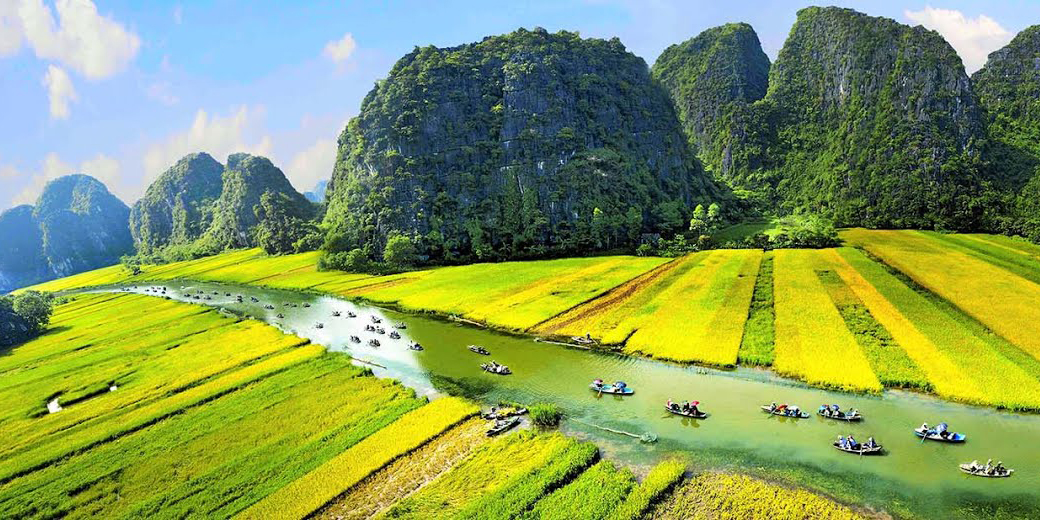
Comments